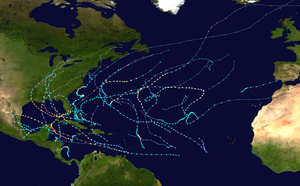| Timeline of the 2005 Atlantic hurricane season | |
|---|---|
 Season summary map | |
| Season boundaries | |
| First system formed | June 8, 2005 |
| Last system dissipated | January 6, 2006 |
| Strongest system | |
| Name | Wilma |
| Maximum winds | 185 mph (295 km/h) (1-minute sustained) |
| Lowest pressure | 882 mbar (hPa; 26.05 inHg) |
| Longest lasting system | |
| Name | Irene |
| Duration | 14 days |
The 2005 Atlantic hurricane season was an event in the annual tropical cyclone season in the north Atlantic Ocean. It was the second most active Atlantic hurricane season in recorded history, and the most extreme (i.e. produced the highest accumulated cyclone energy (ACE)) in the satellite era.[1] Officially, the season began on June 1, 2005 and ended on November 30, 2005. These dates, adopted by convention, historically delimit the period in each year when most tropical systems form.[2] The season's first storm, Tropical Storm Arlene, developed on June 8. The final storm, Tropical Storm Zeta, formed in late December and persisted until January 6, 2006. Zeta is only the second December Atlantic storm in recorded history to survive into January, joining Hurricane Alice in 1955.[3]
The season's impact was widespread and catastrophic. Its storms touched virtually every part of the Atlantic basin.[1] Altogether, there were 28 named tropical storms during the season, exhausting the annual pre-designated list and resulting in the usage of six Greek letter names. A record 15 tropical storms attained hurricane strength, of which a record seven intensified into major hurricanes.[nb 1] Six hurricanes made landfall or near-landfall on the U.S. during the season: Cindy, Dennis, Katrina, Ophelia, Rita and Wilma.[1] Record-breaking 2005 hurricanes included:
- Emily, the strongest hurricane ever on record to form in the month of July, with peak winds of 160 mph (260 km/h), later weakening and striking Mexico twice;[5]
- Katrina, which became the costliest tropical cyclone on record, causing over 1,200 deaths and $125 billion in damage, particularly in the city of New Orleans and the surrounding areas;[1]
- Wilma, which became the most intense Atlantic hurricane on record, recording a barometric pressure of 882 mbar (hPa; 26.05 inHg).[6]
Following the 2005 season, the names Dennis, Katrina, Rita, Stan and Wilma were retired from reuse in the North Atlantic by the World Meteorological Organization.[7]
This timeline documents tropical cyclone formations, strengthening, weakening, landfalls, extratropical transitions, and dissipations during the season. It includes information that was not released throughout the season, meaning that data from post-storm reviews by the National Hurricane Center, such as a storm that was not initially warned upon, has been included. The graphical bar below gives a brief overview of storm activity during the season. Each storm's maximum intensity is represented by the color of its bar.
By convention, meteorologists use one time zone when issuing forecasts and making observations: Coordinated Universal Time (UTC), and also use the 24-hour clock (where 00:00 = midnight UTC).[8] In this time line, all information is listed by UTC first with the respective local time included in parentheses.
- ^ a b c d Dolce, Chris (May 28, 2020). "15 Years Ago, the Most Extreme Atlantic Hurricane Season on Record Began". weather.com. The Weather Channel. Retrieved July 23, 2020.
- ^ Dorst, Neal (June 1, 2018). "Hurricane Season Information". Frequently Asked Questions About Hurricanes. Miami, Florida: NOAA Atlantic Oceanographic and Meteorological Laboratory. Retrieved July 23, 2020.
- ^ AP (January 6, 2006). "Zeta no longer storm, did it break record?". NBC News. Retrieved July 30, 2020.
- ^ "Saffir-Simpson Hurricane Wind Scale". Miami, Florida: National Hurricane Center. Retrieved July 23, 2020.
- ^ Masters, Jeff (April 7, 2006). "No more Katrinas". WunderBlog Archive: Category 6. Brookhaven, Georgia: Weather Underground. Retrieved July 23, 2020.
- ^ Halverson, Jeff; Bettwy, Mike (February 10, 2006). "2005: A Hurricane Season 'On Edge'". Washington, D.C.: NASA. Retrieved July 23, 2020.
- ^ "Tropical Cyclone Naming History and Retired Names". miami, Florida: NOAA National Hurricane Center. Retrieved July 23, 2020.
- ^ "Understanding the Date/Time Stamps". miami, Florida: NOAA National Hurricane Center. Retrieved July 14, 2020.
Cite error: There are <ref group=nb> tags on this page, but the references will not show without a {{reflist|group=nb}} template (see the help page).
© MMXXIII Rich X Search. We shall prevail. All rights reserved. Rich X Search
